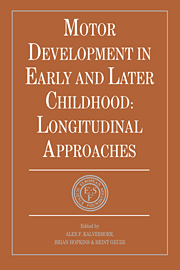Book contents
- Frontmatter
- Contents
- List of contributors
- Foreword
- Preface
- SETTING THE SCENE
- SECTION I BIOLOGICAL BASIS OF MOTOR DEVELOPMENT
- 3 Principles of early motor development in the human
- 4 Natural priorities for developmental study: neuroembryological perspectives of motor development
- 5 The ‘fixed action pattern’ concept revisited: an ethological commentary on the chapters by Prechtl and Provine
- SECTION II DEVELOPMENT OF BODY POSTURE AND GOAL-DIRECTED REACHING
- SECTION III MOTOR DEVELOPMENT, EARLY COMMUNICATION AND COGNITION
- SECTION IV ACQUISITION OF SKILLS
- SECTION V MOTOR DEVELOPMENT AND HANDICAP
- SECTION VI METHODOLOGICAL AND CONCEPTUAL CONSIDERATIONS
- Epilogue: description versus explanation
- Index
5 - The ‘fixed action pattern’ concept revisited: an ethological commentary on the chapters by Prechtl and Provine
from SECTION I - BIOLOGICAL BASIS OF MOTOR DEVELOPMENT
Published online by Cambridge University Press: 05 May 2010
- Frontmatter
- Contents
- List of contributors
- Foreword
- Preface
- SETTING THE SCENE
- SECTION I BIOLOGICAL BASIS OF MOTOR DEVELOPMENT
- 3 Principles of early motor development in the human
- 4 Natural priorities for developmental study: neuroembryological perspectives of motor development
- 5 The ‘fixed action pattern’ concept revisited: an ethological commentary on the chapters by Prechtl and Provine
- SECTION II DEVELOPMENT OF BODY POSTURE AND GOAL-DIRECTED REACHING
- SECTION III MOTOR DEVELOPMENT, EARLY COMMUNICATION AND COGNITION
- SECTION IV ACQUISITION OF SKILLS
- SECTION V MOTOR DEVELOPMENT AND HANDICAP
- SECTION VI METHODOLOGICAL AND CONCEPTUAL CONSIDERATIONS
- Epilogue: description versus explanation
- Index
Summary
THE MODAL ACTION PATTERN (MAP) AS THE BASIC UNIT IN BEHAVIOURAL ORGANIZATION
From an ethologist's point of view the Chapters 3 (Prechtl) and 4 (Provine) in this volume are especially interesting and valuable because of the evidence they give that, from the earliest stages, behaviour is built upon centrally coordinated motor patterns with a capacity for autonomous, spontaneous occurrence, instead of on stimulus-controlled reflexes. This notion is also inherent to the ethological concept of a fixed action pattern, which still features as a major element in the theoretical framework of ethology (Baerends, 1988). The data obtained in the study of prenatal behaviour supplement and consolidate the arguments in favour of it.
The concept was postulated by Lorenz in the early 1930s (Lorenz, 1935, 1937) as a step towards the biological study of ‘instinct’, i.e. the species-characteristic behaviour of animals that contributes to their adaptation to a particular ecological environment. The analysis of this phenomenon requires the distinction of functional units of behaviour that can be studied as entities, just like organs (leg, head, eye) in morphology. Lorenz chose as the fundamental behavioural unit the relatively independent, recurrent, activities with a stereotyped form, which are the constituent elements of more complex behaviour sequences. He called them Instinkthandlung or Erbkoordination, later translated as ‘fixed action pattern’ (FAP). Examples are the various speciesspecific activities that an animal has at its disposal for locomotion, for cleaning parts of its body, for finding, preparing or catching its food, for building a nest, for escaping from predators, and for communicating with conspecifics.
- Type
- Chapter
- Information
- Motor Development in Early and Later ChildhoodLongitudinal Approaches, pp. 74 - 88Publisher: Cambridge University PressPrint publication year: 1993



